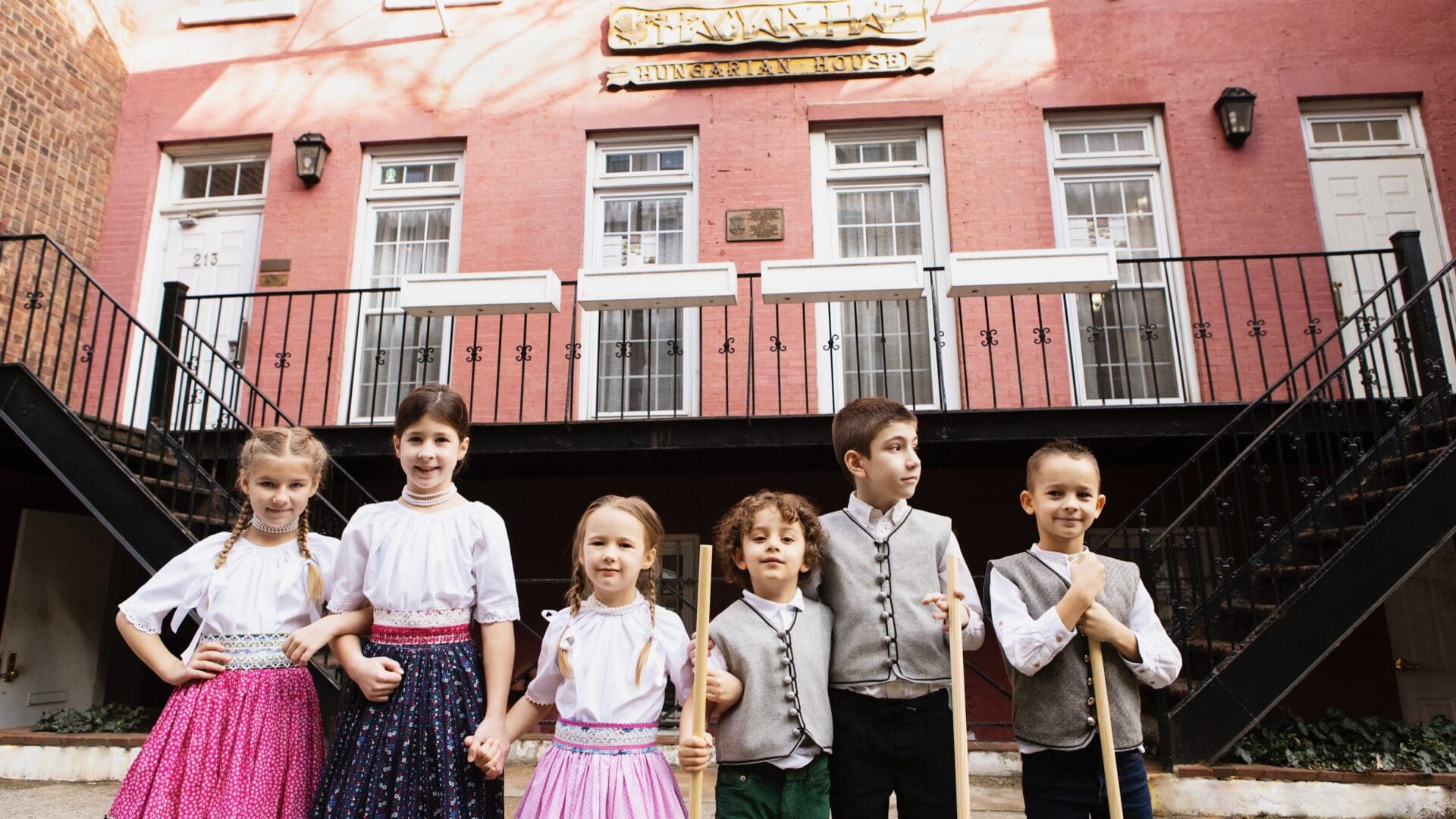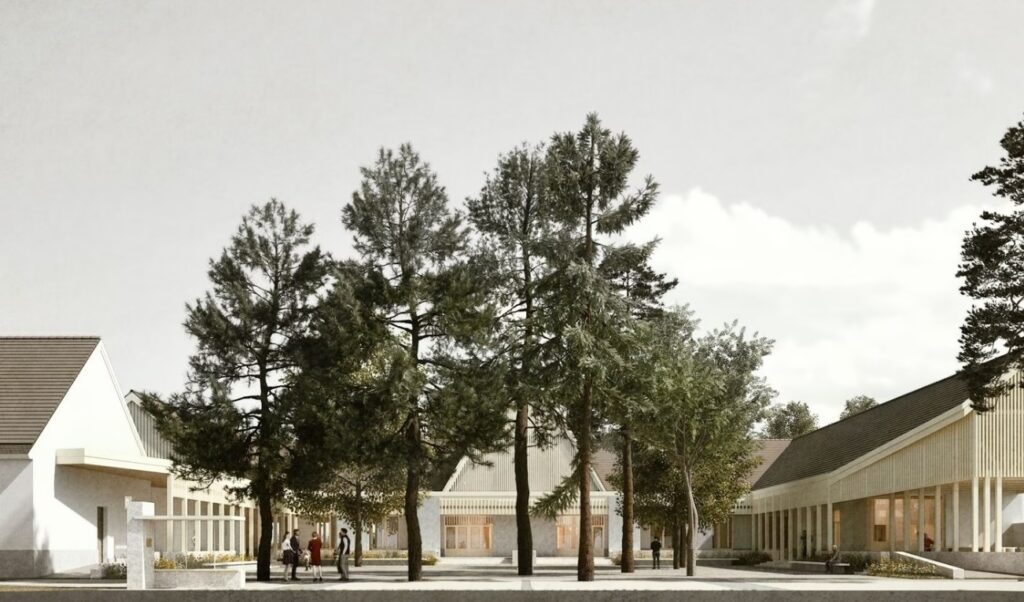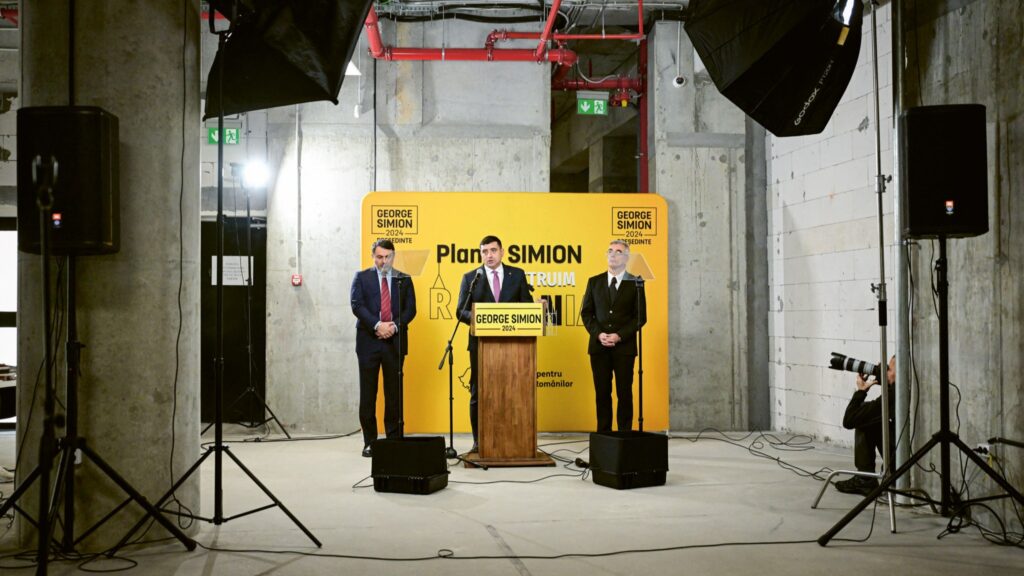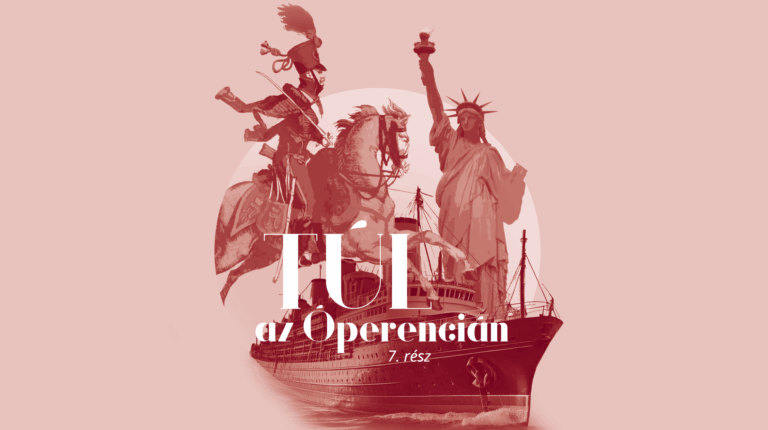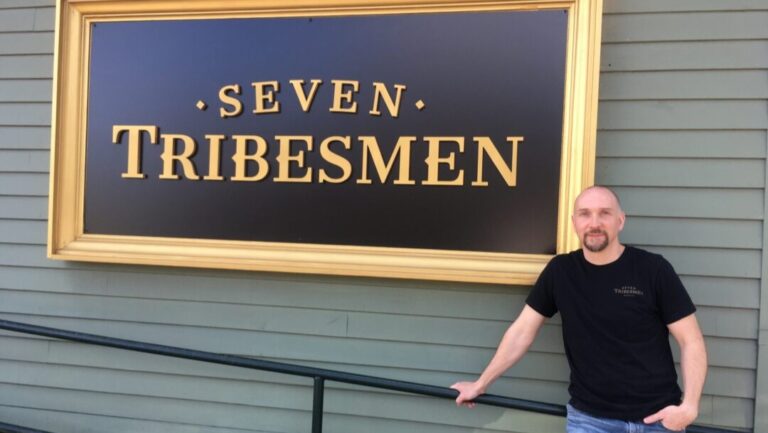The fundraising dinner, held on 28 October 2023, was organized to commemorate the 60th anniversary of the Arany János Hungarian School (‘AJMOI’) in New York and was hosted by the Hungarian Consulate General. Among the 60 guests in attendance, guests of honour included Consul General István Pásztor, Community Diplomat Nikolett Szántovszki and the representative of the Liszt Institute in New York, Noémi Sallai, thanks to whom we enjoyed a beautiful musical programme. Other guests of honour were representatives of institutions that have greatly contributed in recent years to the school’s success, often operating against headwinds. Among them were Imre Lendvai-Lintner, president of the Hungarian Scout Association in Exteris (KMCSSZ), Ákos Rózsa, president of the Széchenyi István Society, Ildikó Nagy, director of the Hungarian House, Mónika Krausz, director of the Tulipán Foundation, as well as Viktor Fischer and Mihály Szarvasy, representing the Hungarian American Memorial Committee.
Founder and first school principal Szabolcs Szekeres revealed that his family emigrated to Argentina after WWII, where some 30–40,000 Hungarians lived in the 50s and 60s, including the cream of the pre WWII Hungarian theatre scene and a strong scout movement. He and his siblings attended a Hungarian school founded by Hungarian nuns who instilled in them a strong sense of Hungarian identity. Nowadays there are only around 3,000 Hungarians left, but a few hundred of them still regularly attend the Zrínyi Club’s events founded by the nuns. These people typically represent the fourth generation of Hungarians since there has been no meaningful Hungarian immigration to Argentina since.
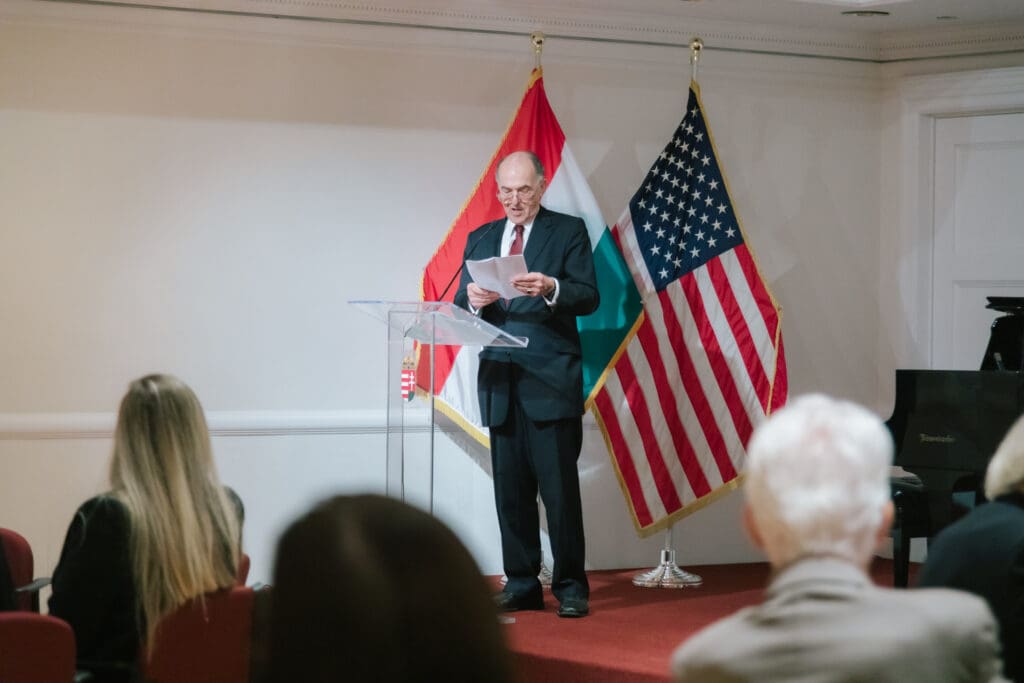
His life in New York started in 1962, at the age of 19, when he enrolled at Columbia University and became involved in the local Hungarian Scout movement, which he knew well from Argentina. ‘I was educated and entertained by the KMCSSZ, and I felt I had to give it back somehow, similarly to several other adult Scouts.’ In New York, Imre Beke suggested establishing an organization similar to the Széchenyi István Free Academy in Brussels. This is how the Széchenyi István Free Academy in New York was launched, where monthly lectures and discussions took place for young adults. When they realized that there were more and more Scouts who knew less and less Hungarian, Imre came up with the idea of founding a Hungarian school that would be independent of the core activities of scouting.
In the spring of ‘63, a teacher training course for teenage Scouts was organized spanning several months, and
in the autumn of that year, the Hungarian school was launched with about 25 children.
Szabolcs Szekeres was the first school principal. ‘At that time, we didn’t think about what would happen 60 years later, we just did it, but I’m very glad the school still exists. I lived in New York City for eight years in the 60s while I was in college, during which time I spent every Saturday in the Hungarian school and with the Scouts. Next year, many of our teachers graduated from high school and moved to universities in other cities, but we did not have the opportunity to offer a months-long training programme once again, so we organized a week-long summer camp. It was both a children’s camp and a teacher training camp: in the mornings the teachers listened to lectures, in the afternoons they worked with the children, i.e. they could turn into practice immediately what they learned during the day. It was a niche and pioneering phenomenon; and KMCSSZ has been organizing such summer school camps ever since.’
Scouts were required to attend Hungarian school, but those who attended school were not required to be scouts. ‘It worked pretty well, even though everyone was a volunteer, and we did not even have textbooks. For example, I recently found my handwritten textbook, where I drew a human body and added the Hungarian names of the body parts to the drawing. Today, education is quite different, with professional teachers and textbooks, which has both advantages and disadvantages. For many years we were housed in St Stephen’s Church, but for a very long time we operated amongst quite harsh conditions, especially after its closure in 2015. However, during the last few years the situation has improved significantly due to financial assistance from the Tulipán Foundation, among other donors.’
Endre Mészáros, the president of the Hungarian Parent–Teacher Association of New York (‘HPTA’), the parent organization of AJMOI, briefly summarized the history of the school. The 95-year-old St Stephen’s Church was situated in the middle of Yorkville, New York’s traditionally ’Hungarian quarter’, where ethnic Hungarians mostly resided until the ‘80s.
The waves of immigration following WWII and the 1956 revolution helped maintain a Hungarian presence in the neighbourhood. Hungarian Scouting took off in 1951, which required a solid command of the Hungarian language as well as Hungarian cultural and historical knowledge. The Hungarian school was founded to prepare children for the Scouts programme. The founders were Scouts and at first even the teachers were Scouts. In subsequent decades parents would typically be part of the teaching staff, but more recently all faculty members are qualified teachers with only one or two school parents among them. As a new development,
there are currently two AJMOI alumni high school students participating as kindergarten teachers’ assistants
with the hope that over time there will be more alumni returning to the school as teachers, providing the backbone of the faculty in the future.
The president highlighted that the school used to have more than one hundred students.
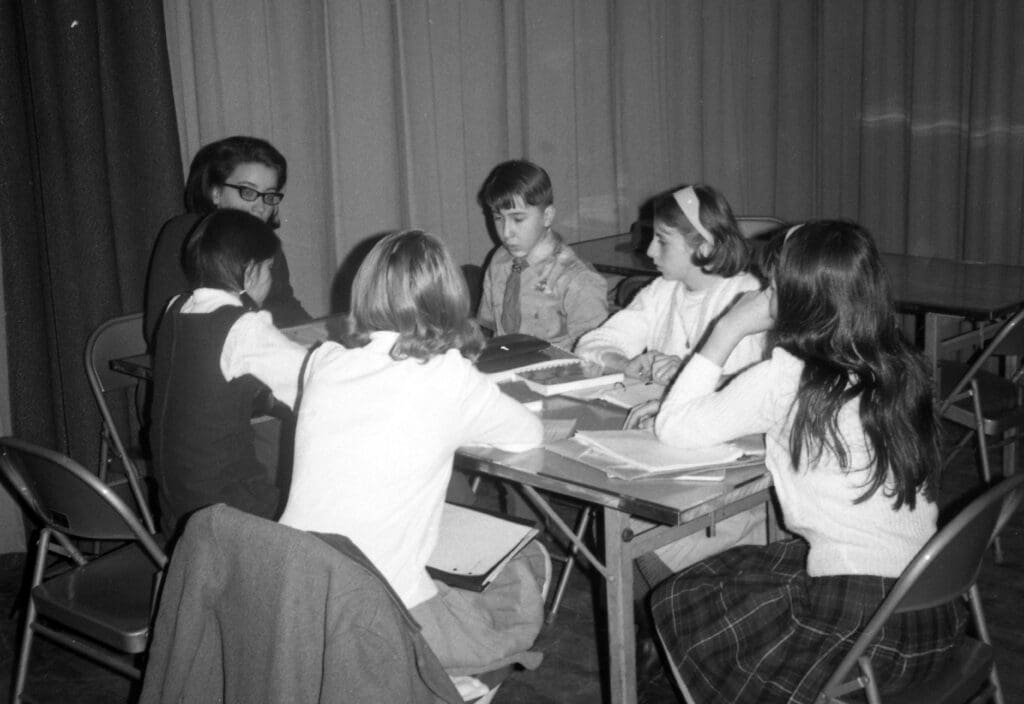
However, over time Hungarians moved out from the Hungarian neighbourhood, the church slipped out of the hands of the Hungarian community, and in 2015 AJMOI needed to abandon the building where it had been located for decades. In the meantime, fewer and fewer children attended the school and even fewer of them participated in the Scouts programme. Fortunately, the Hungarian House and its parent organizations as well as the Hungarian school continued operating in the neighbourhood as flagships of the remaining small Hungarian community. Since 2015 these institutions have helped AJMOI by providing space for their classes at the Hungarian House and the Hungarian Baptist Church on 80th Street. Since 2021, the Tulipán Foundation, the newest member of the Hungarian institutions in Yorkville, houses the school. In the last school year, for the first time in seven years, all classes were able to unite in one location. This is not only practical but also extremely beneficial for building and strengthening community ties. This school year, they had to move again as Tulipán’s building is being renovated, however, the foundation continues to support AJMOI covering 80 per cent of the rental cost of an appropriate school building in the neighbourhood.
Another source of financial support in recent years has been the grant system run by the Hungarian Government through the Bethlen Gábor Foundation,
which enabled the school to have a stable operation over the years and organize many social and community-building programmes. Grants are used to cover the vast part of the remaining 20 per cent of this year’s rent, which is still a significant amount, as well as fund the cost of some of the events organized around the 60th anniversary.
The president explained that the gentrification of Yorkville has had important side effects on the Hungarian community and on the school itself. Currently, families live in various parts of the city, few of them commuting from as far as Connecticut and New Jersey. This often means a one-and-a-half-hour travel by car, subway or train, which is a big effort and dedication to attend the programme every Saturday. Other aspects of life have also changed in recent decades. For example, there is much greater mobility within society in every sense resulting in more marriages with mixed cultures. Two-thirds of the students live in mixed families, half of these hear three languages at home. Teaching Hungarian language and culture is becoming increasingly complicated because of these largely mixed cultural and linguistic backgrounds: ‘It is a challenge for the faculty to group children into classes and to convey the beauties of the Hungarian language to children with such complex language and cultural backgrounds.’
Also, only three out of a hundred parents are second-generation Hungarian Americans. ‘New York is like an immigration hub; this is why it is important to keep our institutions such as the Hungarian school active as they play an important role in the future for new immigrants arriving from the Carpathian Basin.’ Another noticeable change is the composition of pupils. In comparison to past decades, today almost half of the children are of kindergarten age, which is why the word kindergarten has been included in the official name of the institution. In recent years, the leadership
integrated a ’Moms and Tots’ programme
ű in the school called Bóbita for children up to the age of three.
This is one of the most sought-after age groups and is primarily the place where later kindergarteners and active, dedicated parents start their association with the school, continued the president of HPTA. ‘We are proud that despite the Covid pandemic, inflation and social challenges, our school is growing. Today, we have approx. 70 students from 50 families, somewhat more than in 2019. The number of Scouts is also increasing among the students thanks to our collaboration with the KMCSSZ. We have counted 19 Scouts recently, which is roughly two-thirds of our Scout-age student groups!’ AJMOI is thus not only an educational institution for students to learn the Hungarian language, culture and traditions, but also aims to play an integral part in facilitating the integration of young families into the Hungarian community of New York.
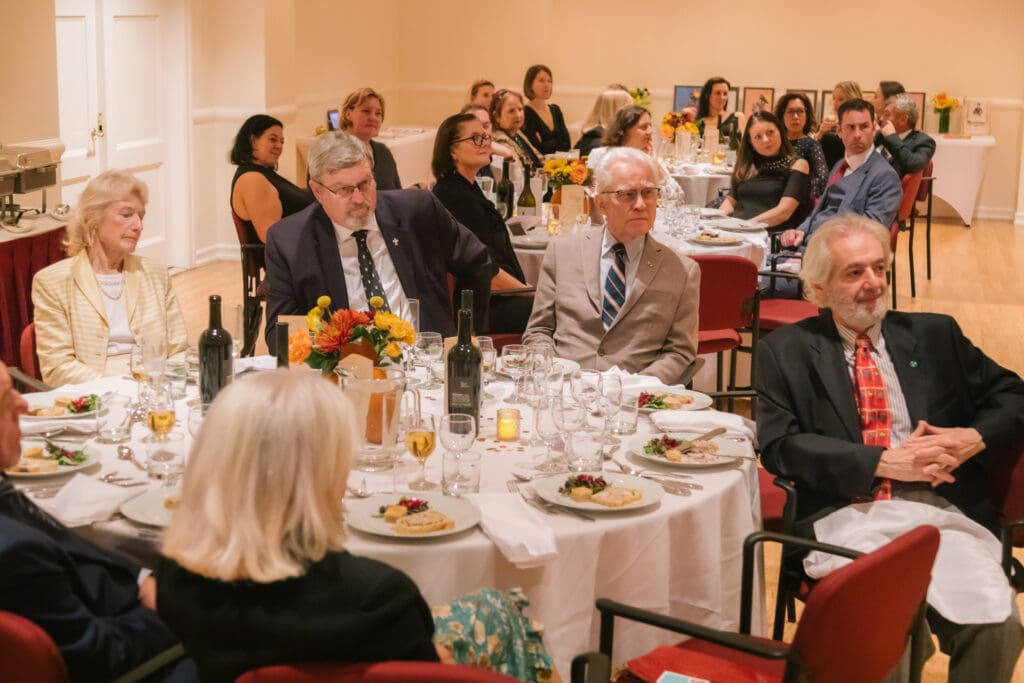
In his closing remarks, Endre Mészáros explained one of the new initiatives of AJMOI. ‘Students usually attend our school until the age of 12–13. At that time, it is hard to know whether they continue practising their Hungarian and take advantage of the opportunities that knowing and understanding another culture brings. Therefore, like other Hungarian schools in the diaspora, we plan to launch a language programme geared towards high school students of Hungarian origin.’ This will involve preparing students aged 14–18 for the ECL Hungarian Language Exam which can provide additional credits when applying to colleges. It should also increase the families’ engagement with the community ensuring its continuity. Funds collected at the fundraiser will be principally used for this initiative.
Zsuzsanna Szalai, who has been a member of the Board of the HPTA for five years and Director of Education for three years, provided an even closer insight. There are seven classes besides the Bóbita group, the average number of students is nine to ten in each class. School hours are from 9:30 am until 12:30 pm on Saturdays. Each class has one teacher, the Pre-K and Kindergarten groups also have assistant teachers. They are all trained professional educators, but do not necessarily teach in line with their original qualifications. ‘We have an amazing kindergarten teacher who originally trained as a middle school mathematics–physics teacher and taught for thirty years in Hungary, but there are also geography teachers, economists and biologists.’
The school places the emphasis on teaching children to be able to speak, read and, to some extent, write in Hungarian, as well as teaching about Hungarian culture, history, and geography. ‘It depends on the age group, but the two oldest classes already know a lot about the lake Balaton region, the Matthias Church in Budapest, or the founding of our country. Many of our students visit Hungary regularly.’ Thus, the goal of the school is to further develop the students’ Hungarian knowledge, which should be established and practised at home, with their parents’ assistance. However, the level of home practice also varies greatly.
A weekend school cannot teach a language if it is not encouraged and practised during the weekdays,
therefore parents also have their roles and responsibilities to cooperate with the school in the interests of the students, the director highlighted.
Nowadays there are many more mixed families in the school than before. At the same time, there are many young Hungarian families who came to the US to work different types of jobs and their children usually speak Hungarian very well. So, the school community is very diverse in many ways, to which education needs to adapt. For example, students are not only allocated by age group, but also based on their understanding and knowledge of Hungarian language, thus there may be an age difference of two to three years between students within one class. ‘The result is an interesting mix, because older students catch up more easily, they are at a higher level in many ways, but it doesn’t mean that their knowledge of Hungarian language is also better. This is a great challenge that cannot really be solved, but we are trying to bridge these gaps as much as possible and make it a great learning experience as well as fun for all.’
The aim of the school today therefore—besides teaching Hungarian language and culture—is that students enjoy the learning process.
‘If you think about it, it’s unlikely that most of them will ever move (back) to Hungary or to the Carpathian Basin; most of them are going to spend their lives in the US (or elsewhere). The Saturday mornings in the Hungarian school will be a distant childhood memory for most of them, so it is important that when they recall those memories, they remember how much they enjoyed those mornings, how well they played, danced, and overall had a joyful and positive experience. Only then is there a chance that they will try to connect to a Hungarian community around them later in their life and pass down their enthusiasm and knowledge of Hungarian language and culture to the next generations. That is the most we can give them.’
Read more:

